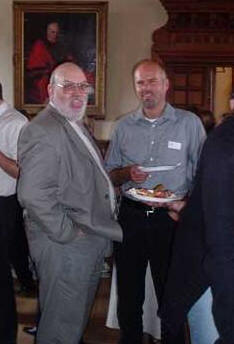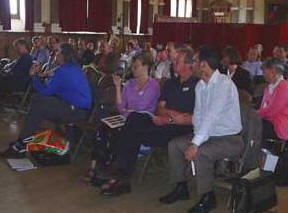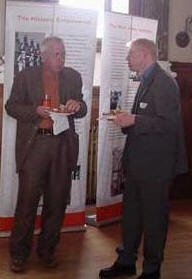 The
Assembly Room within Eastbourne’s Town Hall has a
certain ‘mediaeval’ splendour, albeit of the over-egged,
gloomy, Victorian variety. An almost perfect
setting for a series of expositions on the Byzantine
convolutions of Local Development Frameworks (LDFs) and
the implications for Conservation.
The
Assembly Room within Eastbourne’s Town Hall has a
certain ‘mediaeval’ splendour, albeit of the over-egged,
gloomy, Victorian variety. An almost perfect
setting for a series of expositions on the Byzantine
convolutions of Local Development Frameworks (LDFs) and
the implications for Conservation.
Fortunately, the (eventual) discovery of the light
switches’ location enabled the organisers to dispel the
initial gloom and encouraged positive anticipation of
the enlightenment which was to follow.
The day was chaired by Nigel Barker, who in his usual
animated style introduced the usual nuances, proceedings
of the day and speakers. After the rattling of
cups and shuffling of chairs, the speakers came
forth.
Ralph Dickens of GOSE was the first to take the
stand and was able to spell out the requirements that
would arise following the introduction of LDFs with the
aim of ensuring the right development in the right place
at the right time. The interrelationship between the
various documents – both required and optional – was
spelt out and the relative increased ‘weight’ of the
latter category’s Supplementary Planning Documents (SPDs)
when compared to that of Supplementary Planning Guidance
(SPGs) was emphasised. The bottom line was that detailed
Conservation Policies should be incorporated in the
Development Plan Documents (DPDs) whilst Conservation
Areas might be best dealt with in Area Action Plans (AAPs),
both ‘optional’.
The overall feeling arising from this initial outline of
the LDF process was probably one of some confusion,
particularly insofar as the most appropriate treatment
of Conservation-related issues was concerned.
Steve Williams of English Heritage then applied his
current experience in dealing with Local Plan
consultations to give something of a reality check to
the likely implications of the LDF process for those at
the coal face He expressed his concern that, whilst
there was likely to be an increasing pressure for
development in the settings of historic buildings
leading to a dramatic rise in consultations for EH,
these would probably have to be dealt with without
significant increase in resources. A particular danger
was that the potential increase in ‘standardisation’
would adversely impact on ‘local character’.
On the legal front,
Catherine Davey, Lawyer at Stevens and Bolton
emphasised the need for Officers to ensure that current
‘environmental’ Policies are saved to maintain their
usefulness in the interim period prior to LDFs coming
 on
line.
on
line.
Waverley Borough Council’s
Geraldine Molony followed on with a presentation on
the role of Statements of Community Involvement (SCIs),
using her work on Farnham Conservation Area as a case
study. The mention of having had to consult with over
400 organisations in this particular instance
certainly gave pause for thought, but the advice to
ensure that an auditable record of all actions
(including publicisation of meetings) was kept is of
universal relevance.
After a break for discussion with lunch, the delegates
were treated to a beautifully-crafted ‘Blue Peter’
discourse when
Jeff Collard of Eastbourne Borough Council used his
sticky-backed plastic to good effect, producing mock-ups
of the individual documents comprising an LDF with
‘add-on’ elements for each update necessitated by the
ordered preparation of these documents. Whilst
somewhat light-hearted in tone, the underlying message
was clear, namely that following the required process
would result in considerable, continuing pressure on
resources which are more often than not limited and/or
dependent on Planning Delivery Grants. The implication
being that any loss in funding would inevitably have a
detrimental effect on an Authority’s ability to keep the
LDF process on track.
A second, welcome, interlude was provided by Will Jewell
of Lewes District Council who introduced a short,
humorous, film on LDF’s and promoting community
involvement... Definately thought- provoking and
informative, it’s readily available (for a small fee!)
from LDC. Will can be contacted at
will.jewell@lewes.gov.uk for further information and
orders.

Kate Gordon of CPRE (unfortunately deprived of her
Powerpoint Presentation due to a slight technical hitch)
then helped to focus attention on the potential
assistance which informed local communities could offer
the LDF process, helping to better manage change. She
did, however, point out that consultation with
‘relevant’ groups could be open to abuse and/or misuse
in addition to which there was an underlying risk of
‘consultation fatigue’. Meaningful consultation was the
best way of empowering communities.
The final contribution was made by
Clare Smith of Elmbridge Borough Council who spoke
on Community Conservation Area Appraisals, drawing on
her experience in the Elmbridge Pilot Study. In this
instance, the EH Capacity Building Fund was being used
to encourage community participation with, amongst other
things, Conservation Area design award programmes being
shown to have raised awareness and improved standards.
Clare did, however, emphasise that getting the community
to do the work doesn’t mean to say that officer
involvement is reduced!
Overall, the day was informative but perhaps added to
concerns regarding the implications of the LDF process
for those Authorities with limited resources. Only time
will tell if such concerns prove to be founded in fact
but I for one have considerable reservations as to how
much implementing the new ‘streamlined’ process may cost
the conservation movement.
The content of the powerpoint presentations of the day
are available for viewing to help share the experience
and for some, the learning process.
Sept 2004